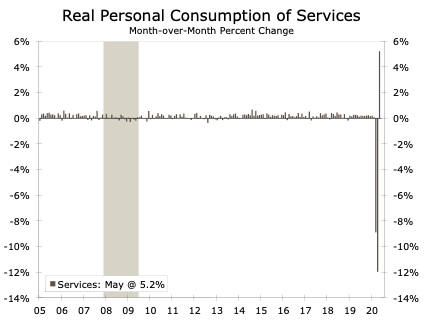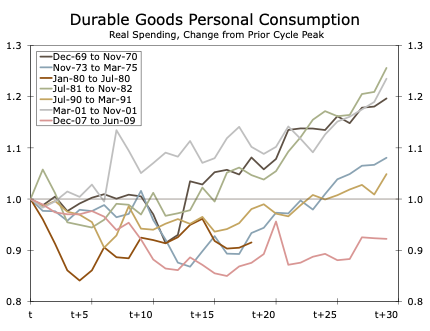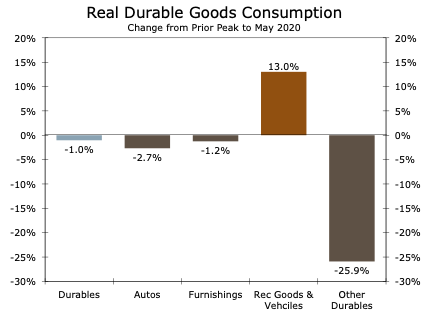While spending on services is still stuck in the grip of COVID-19, goods-related spending is fast-approaching full recovery. Recreation-related spending is more than 10% above its pre-recession peak.
Tim Quinlan, Senior Economist; Shannon Seery, Economist
Wells Fargo Securities, Economics Group, July 01, 2020
Services Spending Recovery Dependent Upon Re-opening
Of all the money spent by consumers in the United States, the largest share (about 64%) goes to spending on services. Although spending here is typically resilient, even in a recession, March and April both saw steep declines, which left services outlays 19.8% below the February peak (top chart). Services ticked up 5.2% in May but have a long way to go, although eventually, once stay-at-home restrictions are lifted, a pent-up demand for services will be a key factor in the shape of the recovery. In an upcoming special report we will examine how the resurgence of the virus could slow that recovery.

Goods Spending is Coming Back Fast
The rest of consumer spending (36%) goes toward goods purchases with a bit more than half on durable goods—the longer-lived and often bigger ticket items—and the rest to non-durable goods—those items with a shorter-lifespan like food, disposable household items and gasoline. Non-durables have held up in this cycle as grocery store spending helped propel non-durable goods spending to a record high in March.
Durables spending is typically where you often see the downside in consumer spending, although the extent of decline and the time it takes to fully recover varies considerably (middle chart). In the wake of 2008-2009 recession, durable goods spending took four years to get back to its former glory compared to about a year and a half on average of the other six recessions. Real durable goods spending rose 29% in May. The peak here was in January, and the surge in May puts the level of durable goods only 1% below that peak. One key factor in the resurgence has come from an unlikely place.

Clark, That There is an RV
You do not typically see spending on recreational goods driving consumer spending during a recession, but that is exactly what is happening in this cycle. The category “recreational goods and vehicles” is more than 10% higher than its February peak, or over $78 billion in annualized dollar terms. Nearly $40 billion of the increase in this category comes from computers and other information processing equipment as homebound workers equip the home office. Spending on sporting equipment is $23 billion above its January peak as households in lockdown have been buying up swing-sets, basketball hoops and trampolines. Perhaps the ultimate discretionary durable good is the recreational vehicle or RV. With flying and hotel stays losing their luster, RV sales jumped nearly $10 billion in May, but this category remains about $2 billion off its prior peak.
The longer road here could be tougher, however. Equipping the home office does not have to happen twice and once the hoop is up, it is there for years. For now though, a surge in recreational goods has helped lift durables spending.

Source: U.S. Department of Commerce and Wells Fargo Securities
Read the report in pdf



